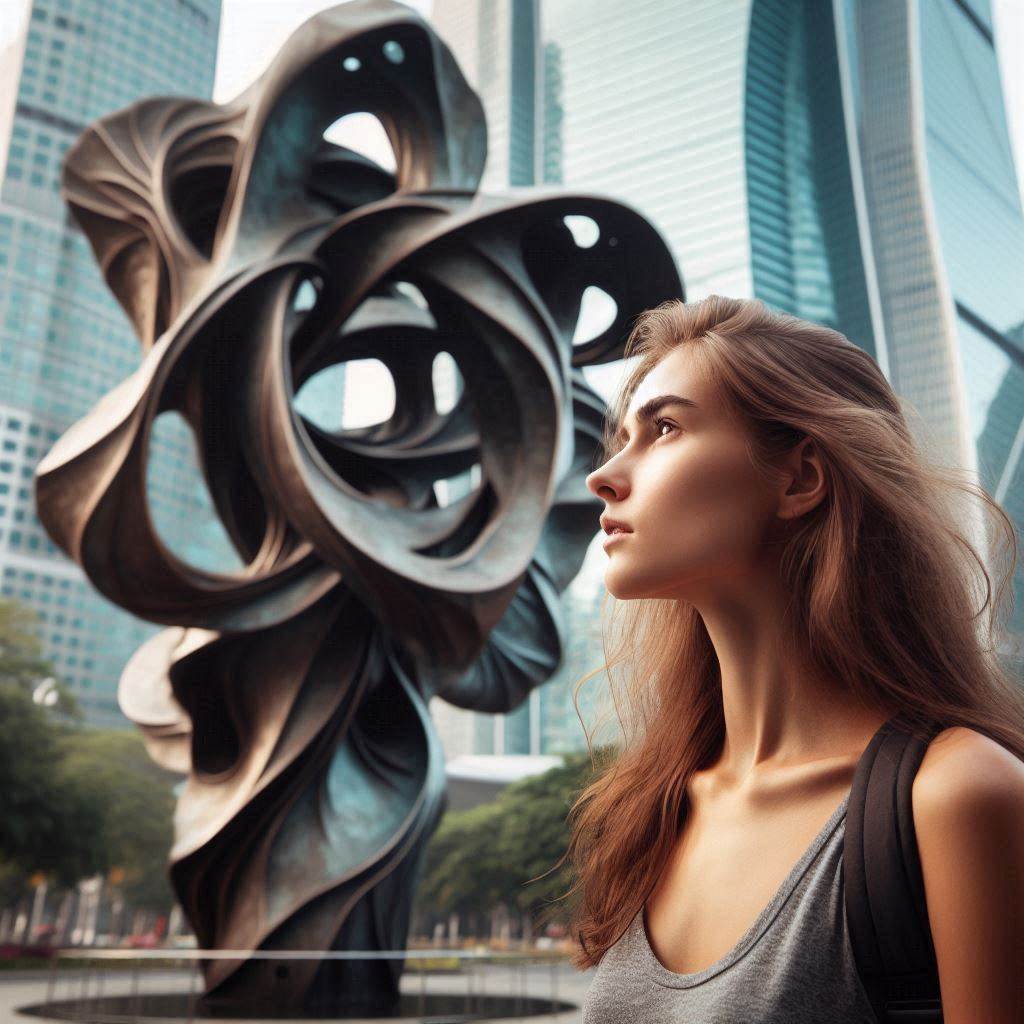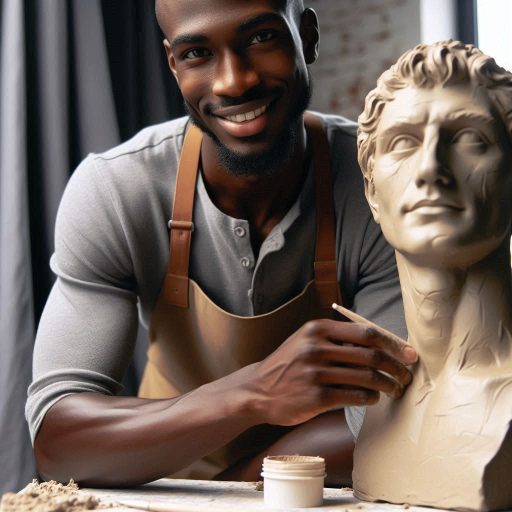Introduction
Sculptures hold a unique place in art history, combining creativity with physical form.
Unlike paintings, sculptures provide a tangible representation of artistic vision.
They offer three-dimensional perspectives and invite viewers to engage from all angles.
This distinct quality makes sculptures a powerful medium for artists to convey emotion and message.
Throughout history, numerous sculptors have left indelible marks on the art world.
Their works are celebrated for their innovation, skill, and impact.
Artists such as Michelangelo, Rodin, and Picasso are iconic figures in sculpture, each contributing uniquely to the field.
Michelangelo’s “David” captures human perfection and strength, while Rodin’s “The Thinker” embodies deep contemplation and introspection.
Picasso’s abstract sculptures push the boundaries of traditional forms, showcasing the evolution of artistic expression.
In this blog post, we will delve into the contributions of these famous sculptors.
We will explore how their groundbreaking works have shaped the world of art.
Additionally, we will examine the techniques and styles that set them apart from their contemporaries.
By understanding their influence, we gain insight into the evolution of sculpture and its ongoing relevance.
Join us as we journey through the masterpieces and the sculptors behind them, discovering how their creativity continues to inspire and captivate audiences worldwide.
Background on Famous Sculptors
The history of sculpture and its evolution
Sculpture, a timeless art form, dates back thousands of years.
Early sculptures, such as those from ancient Egypt and Greece, captured the essence of gods, heroes, and daily life.
Over centuries, sculpture evolved from rigid, symbolic forms to dynamic, expressive pieces.
The Renaissance marked a significant shift in sculpture.
Artists like Michelangelo brought unprecedented realism and emotional depth to their work.
Michelangelo’s “David” and “Pietà” showcased an extraordinary understanding of human anatomy and emotion, setting new standards for sculpture.
Transform Your Career Today
Unlock a personalized career strategy that drives real results. Get tailored advice and a roadmap designed just for you.
Start NowSome of the most renowned sculptors in history
The 19th century saw the rise of Auguste Rodin, whose innovative approach broke away from traditional forms.
Rodin’s “The Thinker” and “The Kiss” are celebrated for their raw emotion and complex textures.
His work paved the way for modern sculpture, emphasizing personal expression over classical ideals.
In the 20th century, sculptors like Pablo Picasso and Henry Moore pushed boundaries further.
Picasso’s abstract works, including “Head of a Woman,” challenged conventional forms, blending cubism with sculpture.
Moore’s large-scale, abstract forms, such as “Reclining Figure,” explored new ways of interacting with space and scale.
Their influence on modern art
These sculptors not only shaped their own eras but also influenced contemporary art.
Michelangelo’s emphasis on human form and emotion continues to inspire, while Rodin’s departure from classical standards encouraged future sculptors to explore personal expression.
Picasso and Moore’s innovations in form and abstraction laid the groundwork for many modern sculptors.
Their contributions have left an indelible mark on the art world.
Today, their iconic works continue to inspire new generations, reflecting the ever-evolving nature of sculpture and its ability to capture the human experience.
Read: Collaborative Projects in Printmaking
Inspiration behind Iconic Works
Many famous sculptors throughout history have created iconic works that have stood the test of time.
Their inspiration often comes from a variety of sources, including personal experiences, social issues, and cultural heritage.
Let’s take a closer look at some of these artists and the inspiration behind their most famous sculptures.
The inspiration behind the famous sculptures created by these artists
Auguste Rodin, known for his masterpiece “The Thinker,” drew inspiration from his studies of human anatomy and his fascination with Dante’s Inferno.
The sculpture embodies deep contemplation and the human experience.
Michelangelo’s “David” was inspired by the biblical story of David and Goliath.
His attention to detail and mastery of form captured the strength and beauty of the human body in a way that had never been seen before.
The different themes and motifs depicted in their works
Barbara Hepworth, a pioneer of modern sculpture, often explored themes of motherhood and the relationship between humans and nature.
Transform Your Career Today
Unlock a personalized career strategy that drives real results. Get tailored advice and a roadmap designed just for you.
Start NowHer abstract works, such as “Pelagos,” reflect a deep connection to the landscape and the natural world.
Louise Bourgeois, known for her poignant and often unsettling sculptures, delved into themes of trauma, memory, and the subconscious.
Works like “Maman,” a giant spider sculpture, symbolize the protective and threatening aspects of motherhood.
The impact of their creations on the art world
Pablo Picasso revolutionized the art world with his innovative approach to sculpture.
His works, such as “Bull’s Head,” challenged traditional notions of form and space, paving the way for future generations of artists to experiment and push boundaries.
Claes Oldenburg, known for his oversized and playful sculptures of everyday objects, brought a sense of whimsy and humor to the art world.
Pieces like “The Clothespin” and “Spoonbridge and Cherry” transformed public spaces and encouraged viewers to see the world in a new light.
In a nutshell, the inspiration behind iconic sculptures often stems from a deep connection to personal experiences, cultural heritage, and social issues.
These themes and motifs are masterfully depicted by famous sculptors, leaving a lasting impact on the art world and inspiring future generations to push the boundaries of creativity and innovation.
Read: Exploring Career Opportunities in Art and Design

Michelangelo
Brief biography of Michelangelo
Michelangelo di Lodovico Buonarroti Simoni, known as Michelangelo, was a Renaissance master born in 1475 in Caprese, Italy.
His early artistic talents were evident, leading him to study under renowned masters.
Michelangelo’s career spanned sculpting, painting, and architecture, making him a pivotal figure in art history.
His most famous works such as “David” and the Sistine Chapel ceiling
Michelangelo’s “David” is one of his most famous sculptures.
Created between 1501 and 1504, it captures the biblical hero before his battle with Goliath.
The statue’s detailed anatomy and poised stance exemplify Michelangelo’s mastery of human form.
Another of his renowned works is the Sistine Chapel ceiling, painted between 1508 and 1512.
This fresco depicts scenes from the Book of Genesis, including the iconic “Creation of Adam,” where God reaches out to touch Adam.
Michelangelo’s techniques reveal his artistic genius.
In “David,” Michelangelo used marble to create a lifelike figure with intricate detail, showcasing his skill in capturing human emotion and anatomy.
Transform Your Career Today
Unlock a personalized career strategy that drives real results. Get tailored advice and a roadmap designed just for you.
Start NowThe statue’s proportions and realism are notable, reflecting his deep understanding of human physiology.
On the Sistine Chapel ceiling, Michelangelo employed fresco painting, a technique involving applying pigments onto wet plaster.
This method allowed for vivid colors and durability.
His compositions are dynamic, with figures appearing almost three-dimensional.
The use of foreshortening and dramatic poses adds depth and movement, bringing biblical narratives to life.
The techniques and artistic style employed by Michelangelo
Michelangelo’s artistic style blends classical ideals with his unique vision.
His ability to convey emotion and detail in both sculpture and painting set new standards for art.
His works continue to inspire artists and captivate audiences worldwide.
Read: Printmaking Techniques: Etching and Engraving
Auguste Rodin
Introduction to Auguste Rodin and his significance in sculpture
Auguste Rodin stands as a pivotal figure in the world of sculpture.
His work bridges classical techniques and modern expression, making him a revolutionary artist of his time.
Rodin’s sculptures break from tradition, focusing on raw emotion and naturalistic detail.
His influence on sculpture is profound and enduring.
His iconic sculptures like “The Thinker” and “The Kiss”
One of Rodin’s most celebrated works is “The Thinker.”
Initially part of a larger piece called “The Gates of Hell,” this sculpture depicts a solitary figure deep in contemplation.
The Thinker embodies intellectual struggle and introspection, capturing a universal human experience.
The powerful physique and intense expression showcase Rodin’s skill in portraying complex emotions.
Another iconic work by Rodin is “The Kiss.”
This sculpture illustrates a passionate embrace between two lovers.
The work is renowned for its sensuality and the tender interaction between the figures.
Transform Your Career Today
Unlock a personalized career strategy that drives real results. Get tailored advice and a roadmap designed just for you.
Start NowRodin’s ability to convey affection and intimacy through stone demonstrates his exceptional talent.
The themes and emotions portrayed in Rodin’s works
Rodin’s sculptures often explore themes of love, struggle, and the human condition.
His figures are not idealized but instead reflect real human experiences and emotions.
By focusing on the physicality of the human form, Rodin emphasizes the internal conflicts and passions that drive people.
In Rodin’s art, emotion and realism merge seamlessly.
His approach allows viewers to connect deeply with the human experience.
Through pieces like “The Thinker” and “The Kiss,” Rodin’s legacy endures.
His work continues to inspire and influence sculptors and artists around the world.
Rodin’s impact on modern sculpture is immense.
His innovative techniques and profound thematic explorations remain a source of inspiration.
Rodin’s legacy, characterized by emotional depth and realistic detail, still resonates in the art world today.
Read: Printmaking Techniques: Chine-collé Basics
Barbara Hepworth
Overview of Barbara Hepworth’s Background and Career
Barbara Hepworth was a leading British sculptor born in 1903 in Wakefield, England.
She studied at the Leeds School of Art and later at the Royal College of Art in London.
Hepworth moved to St Ives, Cornwall, in the 1930s, which became her artistic base.
Her career spanned over five decades, and she became known for her abstract and modernist sculptures.
Hepworth’s work significantly influenced 20th-century sculpture, making her a prominent figure in art history.
She passed away in 1975, leaving a legacy of groundbreaking work.
Her Unique Style and Approach to Sculpture
Barbara Hepworth is celebrated for her abstract forms and innovative use of materials.
Her style evolved from early figurative work to highly abstract forms.
Transform Your Career Today
Unlock a personalized career strategy that drives real results. Get tailored advice and a roadmap designed just for you.
Start NowHepworth often carved directly from stone and wood, using simple, organic shapes.
Her sculptures frequently feature smooth, rounded forms with hollowed-out sections, creating a dialogue between solid and void.
She emphasized the tactile and spatial qualities of her pieces.
Hepworth also experimented with different textures and surfaces, enhancing the sensory experience of her work.
Her approach combined technical skill with a deep sense of natural harmony.
Her Famous Works and Their Impact on the Art World
Among Hepworth’s most famous works is “Single Form,” a monumental bronze sculpture located at the United Nations in New York.
This piece reflects her interest in form and space and is admired for its elegance and simplicity.
Another notable work, “The Family of Man,” showcases her ability to convey human relationships through abstract forms.
Hepworth’s sculptures had a profound impact, inspiring many contemporary artists.
Her innovative techniques and dedication to abstraction helped redefine modern sculpture.
Through her work, Hepworth left an enduring influence on the art world, celebrated for its originality and depth.
Conclusion
Famous sculptors have left an indelible mark on the art world.
Their iconic works continue to inspire and evoke emotions in viewers.
The significance of their contributions cannot be overstated, shaping the way we perceive art.
These artists have paved the way for future generations of sculptors to follow.
The works of famous sculptors have become timeless masterpieces that transcend generations.
From Michelangelo’s David to Rodin’s The Thinker, these sculptures have become cultural symbols.
Their artistry and craftsmanship have set the standard for excellence in sculpting.
These iconic works serve as a testament to the creativity and vision of these renowned sculptors.
The legacy of famous sculptors lives on through their enduring works that continue to captivate audiences.
Transform Your Career Today
Unlock a personalized career strategy that drives real results. Get tailored advice and a roadmap designed just for you.
Start NowTheir influence can be seen in contemporary art, inspiring new generations of artists.
These sculptors have immortalized their names through their groundbreaking contributions to the art world.
Their lasting legacy serves as a reminder of the power of art to transcend time and space.
I encourage readers to delve deeper into the works of famous sculptors to fully appreciate their artistry.
Exploring the stories behind these iconic works can provide valuable insights into the artists’ creative processes.
By learning more about these renowned sculptors, we can gain a deeper appreciation for the art form and its impact on society.
I hope that this exploration inspires readers to seek out these sculptures and experience their beauty firsthand.
[E-Books for Sale]
The Big Book of 500 High-Paying Jobs in America: Unlock Your Earning Potential
$19.99 • 500 High-Paying Jobs • 330 pages
Explore 500 high-paying jobs in America and learn how to boost your career, earn more, and achieve success!
See All 500 High-Paying Jobs of this E-Book
1001 Professions Without a Degree: High-Paying American Jobs You Can Start Now
$19.99 • 1001 Professions Without a Degree • 174 pages
Discover 1001 high-paying jobs without a degree! Unlock career tips, skills, and success strategies for just $19.99!




